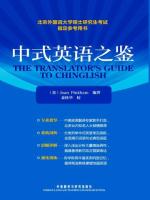之鉴
黄艳玲
The third and fourth chapters of this edition discuss the problem of
synonymous accumulation. The third chapter, "synonym
accumulation", discusses this problem from the word level. The
fourth chapter starts from the level of clauses and warns readers not to
"say the same meaning twice". In the end, the author adds that
in Idiomatic English, synonyms often overlap. Personally, how to grasp
this degree is a particularly difficult problem. The second section,
"Sentence Structure", analyzes the sentence construction
features of Chinglish from six aspects: noun swelling, pronoun and
antecedent, position of phrase and sentence, hanging component, parallel
structure and logical conjunction. The author aims to help Chinese
people translate or write English sentences with clear meaning and clear
logic. Here is just an example of noun swelling in the first aspect: The
Theprolongationoftheexistenceofthistempleisduetothesolidityofits
constructions Consider: Thetemplehasenduredbecauseitwassolidlybuilt.
Using two verbs and an adverb instead of an abstract noun, the
translated version conveys the meaning more clearly, vividly and
cleanly. It is worth noting that the author also mentioned that the
documents of academic institutions, governments and large companies tend
to use abstract nouns, because such use would make people feel rigorous
and formal. As for me, Recently I participated in the website
translation project of the Ministry of Foreign Affairs, and I was deeply
touched. But I do not think this is inconsistent with the section
against "noun swelling". One of the criteria for idiomatic
English is "brevity", which is allowed if abstract nouns (also
called inanimate nouns) are used to achieve this effect. However, the
term "noun swelling" mentioned in this chapter not only fails
to meet the above criteria, but also reduces the expressive power of
language. From "pronouns and antecedents" to "logical
conjunctions", the author takes Chinglish as a negative teaching
material to guide readers to get rid of the influence of Chinese and
Chinese thinking, and construct sentences with proper collocation of
pronouns and antecedents, modifying elements and modifying targets
grammatically and logically. Pinkham, the author of Chinglish lessons,
is a native English speaker. She USES English thinking mode to summarize
and sort out the weaknesses of Chinglish, and points out her thoughts
and thoughts when reviewing the original works, so as to guide readers
to avoid Chinglish in a subtle way. Throughout the book, the author
makes no mention of translatology terminology. In her opinion,
translation is not only a science, but also a craft. Based on this idea,
A Guide to Chinglish analyzes and argues with a large number of
examples, so that readers can fully develop their Way of thinking in
English. The exercises after each project also provide the reader with
hands-on opportunities to reinforce what he has learned. There is no
doubt that the book will be of practical value to Chinese readers, since
the examples cited are all of Chinese character. However, due to the
rapid changes in China's national conditions, many examples are
unfamiliar to read, which is also a pity. The book provides a meaningful
reference for us to shift our thinking, but linguistic phenomena are too
complex to be solved by reading it. At most, it points out a direction
on our English learning path. In order to improve the expression level
of authentic English, we should pay attention to the accumulation and
arrangement of ordinary knowledge.




 京公网安备 11010802032529号
京公网安备 11010802032529号